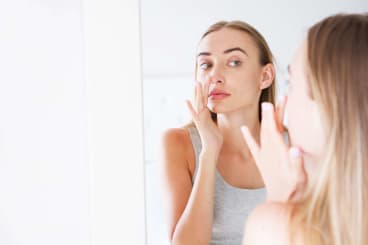 Closed Rhinoplasty
Closed RhinoplastyReinventing Rhinoplasty: What's Different About Modern Nose Jobs
The days of cookie-cutter, overly-done nose jobs are disappearing. We spoke with Dr. Jason Roostaeian about how innovative surgical techniques and new technologies are changing what we can expect from a rhinoplasty.
In recent years, both the art and science of rhinoplasty have been experiencing an evolution. Innovative surgical techniques, combined with inventive new technologies, are generating greater options for both surgeons and patients alike. For people seeking nose surgery, this means that the days of cookie-cutter, overly done noses are disappearing, replaced by a custom approach that respects each patient’s unique aesthetic and anatomy.
According to board certified UCLA Associate Professor of Plastic Surgery, Dr. Jason Roostaeian, “The biggest difference between historical surgical technique and modern rhinoplasty technique is the shift from a reductive to a structural approach.” In the past, facial plastic surgeons focused primarily on removing tissue to reduce the size and/or change the proportions of the nose, a technique that often led to too much tissue being discarded. Reductive nose reshaping could eventually form scar tissue, which often warped whatever cartilage remained and tightened the soft tissue, creating both breathing issues as well as the sloped, saddle nose and pinched nasal tip we often associate with nose jobs. That has all changed. “With structural rhinoplasty,” Dr. Jason says, “We utilize what’s already there – the nasal bones and internal cartilaginous framework – but rearrange and sculpt it so that we end up with a more stable and predictable result that stands the test of time.”
A Tailor-Made Nose Job
“Think about the nose as a two-story house, with the skin being the roof and exterior siding, and the cartilage and soft tissue inside are the wooden framework and the drywall," says plastic surgery resident Dr. Sean Saadat. "In the old days, surgeons would go in, demolish the second floor, and put the roof back on. Now, we take the whole house down to the studs, redesigning and fortifying it when necessary, before we cover it back up.”
Practically speaking, this translates into a more harmonious result that better blends with a patient’s existing facial proportions. It also means that patients are less likely to be faced with complicated revisions. When they are, cosmetic surgeons now have a better understanding of how to correct a previous nose job. However, correcting mistakes made during prior rhinoplasties is no easy task. “Not every plastic surgeon does revision rhinoplasty,” says Dr. Jason. “It requires considerably more thinking, planning and creativity than primary procedures because you never know what you’re going to get. To use the construction analogy, it’s like coming in after the demo and trying to figure out what we’re going to use to rebuild and how we’re going to use it.”
Achieving these more natural, lasting results takes time. Surgery times for rhinoplasty have increased from an average of one or two hours to sometimes five hours or longer, particularly in revision cases. According to Dr. Saadat, this is due in part to the more targeted approach. “There is a better understanding that ideally, you disrupt the internal nasal structure as little as possible," he says. "Injury leads to inflammation, which leads to scarring, which can cause both functional and aesthetic problems down the road.”
The Role of Technological Advancements
Even though rhinoplasty patients are spending more time under general anesthesia, technological advances are allowing them to heal more quickly and comfortably and see results that better match their expectations. Historically, surgeons packed the nose full of gauze in the operating room, which led to considerable patient discomfort for a week following surgery. These days, doctors can instead insert hollow silicone stents inside each nostril, which allow patients to breathe properly from the moment they wake from anesthesia. To protect the exterior of the nose, Dr. Jason also uses new splint technology from MirrorMe3D. “Traditional splints are essentially casts applied to the patient after surgery, but this transparent device is completely custom molded to each individual via 3D imaging," he says. "It provides a superior level of protection from post-operative swelling, and also allows patients a sneak peek at their healing nose.”
While all of this innovation is impressive, Dr. Jason discourages patients from relying exclusively on bells and whistles when choosing their rhinoplasty surgeon. “Computer software that simulates a patient’s potential result is certainly useful, but generating the images is time-consuming and limited by your surgeon’s skill with Photoshop," he says. Dr. Jason encourages patients who are researching rhinoplasty doctors to study their prospective surgeon’s before-and-after photographs to get a strong sense of their skill and aesthetic. Dr. Saadat, who chose his primary nose surgeon solely on the basis of the 3D technology the doctor used, has since reconsidered its importance. “3D technology can show you the vision your plastic surgeon has for you, but their before-and-after photos demonstrate their ability to execute that vision. It’s a fine balance.”
Fortunately, an increasing number of modern rhinoplasty procedure patients are able to benefit from that balance and it's a trend that will continue as long as plastic surgeons continue matching skill with science. “Technology is clearly crucial to modern rhinoplasty," says Dr. Jason. "It comes down to taking advantage of the advances in technique and technology and to whether or not your plastic surgeon is able to really utilize those advances to provide a superior experience.”
Related Procedures

AI Plastic Surgeon™
powered by'Try on' aesthetic procedures and instantly visualize possible results with The AI Plastic Surgeon, our patented 3D aesthetic simulator.
